Apple iPad mini with Retina Display: Reviewed
by Anand Lal Shimpi on November 16, 2013 8:00 AM ESTThe Display
The big story behind the new iPad mini is of course its 7.85-inch Retina Display. We’re talking about the same 2048 x 1536 resolution as the iPad Air, but in a much smaller form factor. The result is the highest pixel density of any Apple display ships today, tying with the iPhone 5S. The impact on the overall experience is pretty significant. Text is obviously a lot sharper, but even graphics are a lot nicer to look at on the new Retina Display. The gains aren't quite as obvious as they were on the larger iPad, but after living with the Retina mini for a while I can't easily go back to the previous version.

iPad mini (left) vs. iPad mini with Retina Display (right)
I ran Marco Arment's image retention test on the Retina mini and didn't see even the slightest degree of image retention. My old, non-Retina iPad mini on the other hand exhibited image retention. I suspect Apple is multi-sourcing its displays here, which could obviously contribute to varied behavior. At least on the two minis I have, image retention isn't an issue.
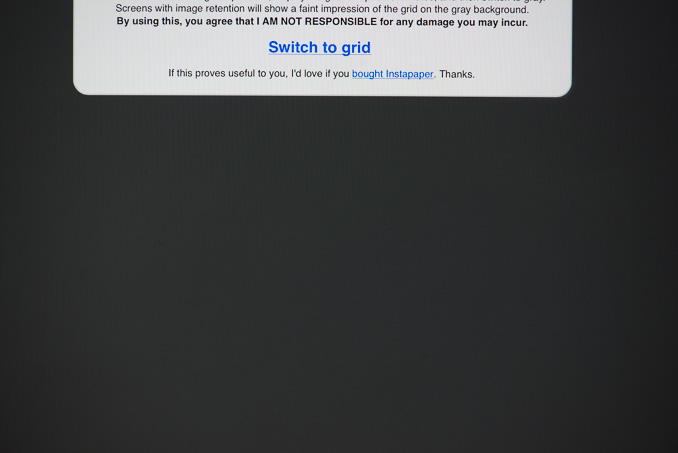
In the conclusion of my iPad Air review I wrote about the new mini as finally being a no-compromises smaller iPad. Much like my assertions last year of a Retina mini not being in the cards, it turns out that I was wrong on this point as well. Although display resolution is no longer a concern on the mini, color gamut hasn’t changed between the old and new minis. A quick look at our gamut test gives us an idea of what’s going on:

The iPad mini with Retina Display has the same color gamut as the standard iPad mini, which is narrower than the iPad Air and less than the sRGB coverage we normally look for. The biggest issue here is that there are other smaller tablets in this price range that do offer sRGB coverage (e.g. Nexus 7, Kindle Fire HDX 8.9).
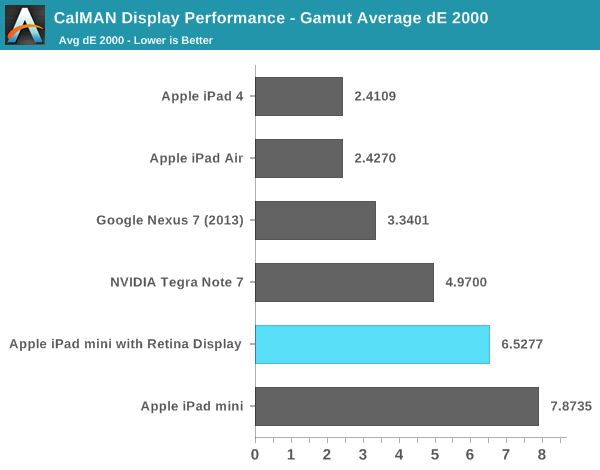
I suspect the justification here is Apple likely views the bigger iPad as being a better fit for photographers/those who care about color reproduction, but it’s a shame that this is a tradeoff that exists between the two iPads especially given how good Apple is about sRGB coverage in nearly all of its other displays.
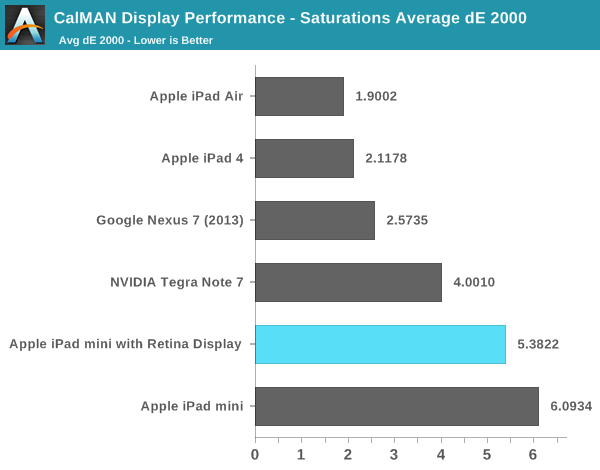

One of the simplest visual tests is to use one of iOS 7’s more colorful wallpapers and compare the Retina mini and iPad Air side by side:
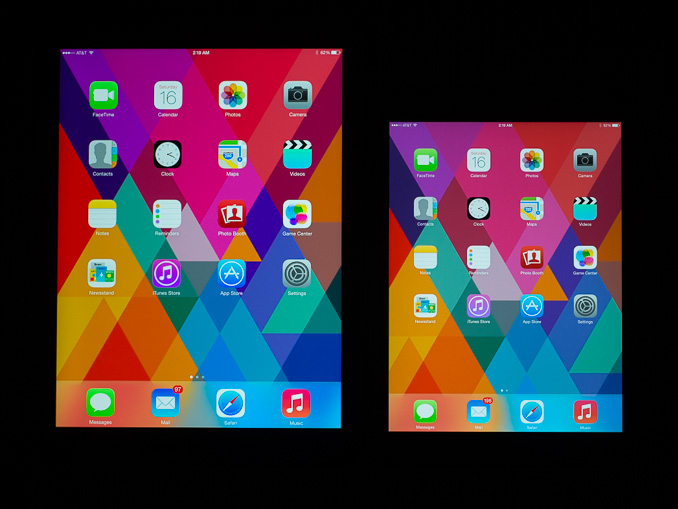
Pay attention to the color of the red triangles in the lower left
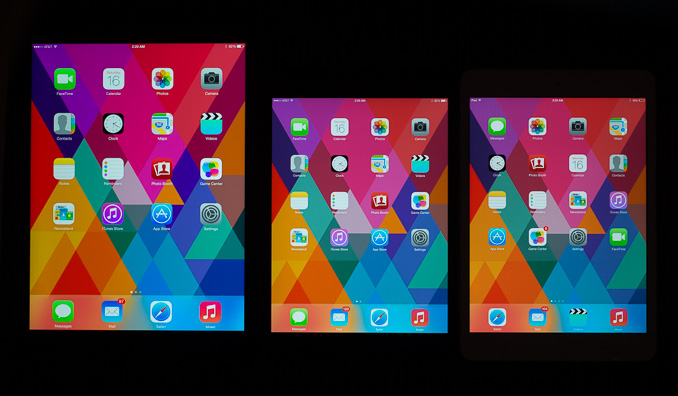
From left to right: iPad Air, iPad mini with Retina Display, iPad mini
The difference is small but apparent, particularly if you’re used to panels with full sRGB coverage like the iPad Air or any of the rMBPs/iMacs. The biggest deviations are in reds/blues and magenta in between as you can tell from the CIE chart above.

Within its gamut coverage, the mini’s panel is fairly accurate. A look at our GMB checker test shows performance competitive with the Nexus 7 and not far off the 4th generation iPad. Grayscale reproduction is also quite good. The display looks really good otherwise, but you don’t get the same visual punch you do on the iPad Air.
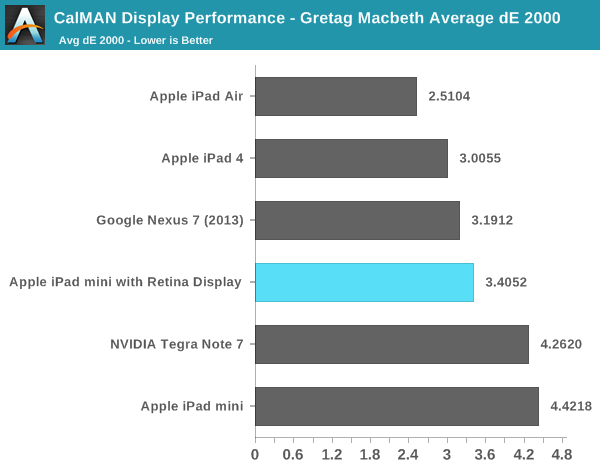

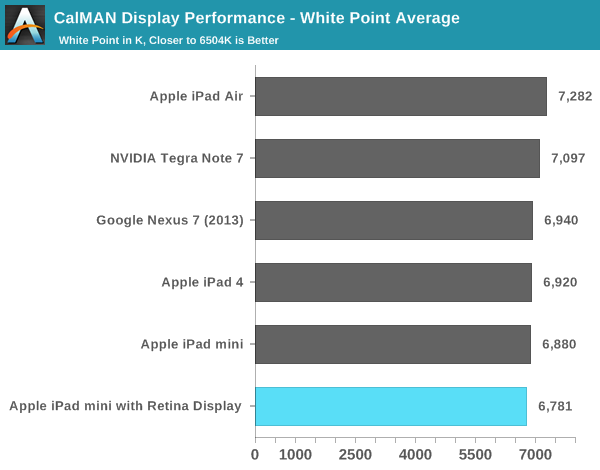
Compared to the previous generation mini we’re obviously talking about a much better panel. But for those of you on the fence between the mini and Air, the Air does still hold a display advantage.
Black levels are competitive and contrast ratio stays fixed at around 800:1 regardless of whether we’re talking about max brightness or the 200 nits we run all of our battery life tests at. Max brightness is down a bit compared to the iPad Air.
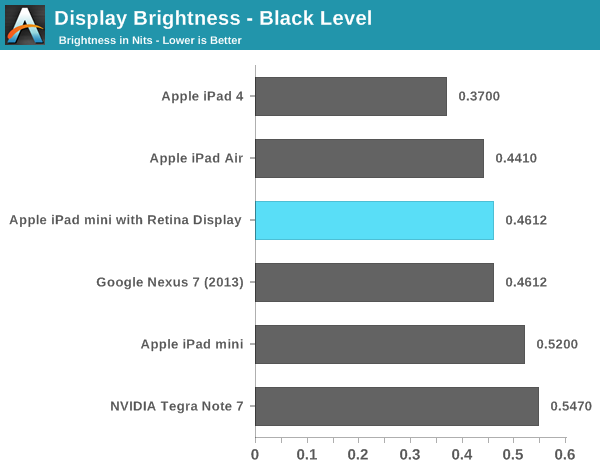
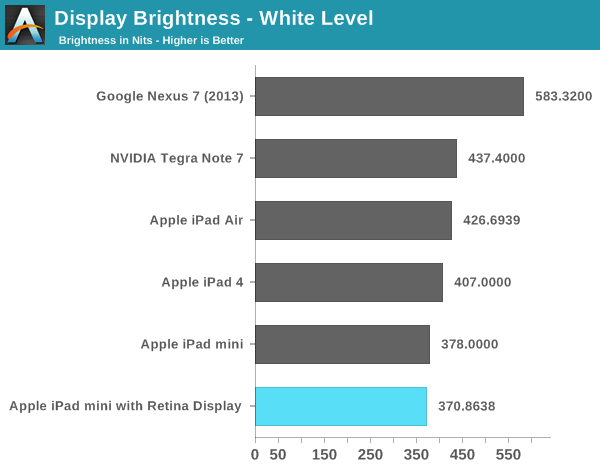
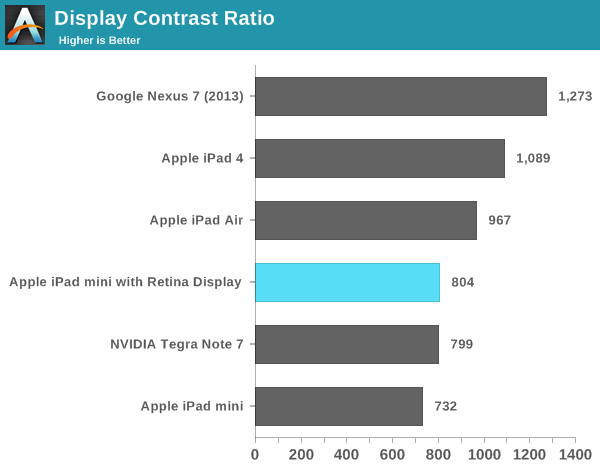










345 Comments
View All Comments
kyuu - Saturday, November 16, 2013 - link
Bay Trail tabs seem to be charging $50 to go from 32GB to 64GB (32GB upgrade). While still more of a premium than it really should be for cheap eMMC NAND, it's a helluva lot better than the $100 for 16GB to 32GB (16GB upgrade) Apple is sticking with.Daniel Egger - Saturday, November 16, 2013 - link
And which *premium* devices are you talking about? The 2 different vendors offering different memory configurations with BayTrail are Asus and Toshiba. Both are not premium and yet Toshiba is asking 50€ to go from 32GB to 64GB and ASUS even 80€ for the same. Dell, HP and Lenovo only offer one configuration at the moment.Anywhoo, while Apple is not cheap they're by far not the most expensive (see HTC, but there're other examples as well) and they're very consistent in their pricing and go all the way up to 128GB.
kyuu - Saturday, November 16, 2013 - link
Huh? I didn't use the word "premium" in the context of a device being nice or not, so I don't know why you're bringing it up that way. The build quality of many of the Windows tabs are equal to, if not better than, the iPad anyway.I'm actually not aware of any Win8.1 tabs that don't have different memory configurations, and none of them charge $100 for 16GB of NAND, or even for 32GB of NAND. I don't understand what you're trying to get at. I couldn't care less if Apple goes up to 128GB of NAND when they're charging $300 for ~$20 worth of NAND.
Also, it's certainly not "consistent" to charge $100 for 16GB of NAND, then $100 for 32GB of NAND, then $100 for 64GB of NAND.
akdj - Sunday, November 17, 2013 - link
These aren't SanDisk Best Buy SD cards they're shipping. Look at the pricing on decent flash memory, IE, CompactFlash. All manufacturers using real NAND are paying many more dollars than 5 per doubling of capacity. Probably with Windows, the OS and it's bloat take UP all the NAND....and I'm not sure the world you're living in, but there's not a single Win8.1 tablet that comes close to the build quality....of even the earliest of iPads. The new Air and rMini....works of engineering art. Top shelf. Doesn't get ANY better. Certainly not Win 8.1 tablets. Sorry.Morawka - Sunday, November 17, 2013 - link
Nand at these capacities is dirt cheap. Think of how many 16GB chips are in a 128GB Consumer SSD? 8 of them. And the ssd's MSRP is $119 and included in that cost is a storage controller, casing, PCB, and of course, NAND.When you pay for a apple nand upgrade, your just paying for more nand, period.
kwrzesien - Monday, November 18, 2013 - link
Your right, they pay WAY more. BOM increase for 32GB over 16GB is $13! That's over double $5!/s
RadarTheKat - Monday, November 18, 2013 - link
And how much is the Surface keyboard, without which the device is not very usable? Talk about gouging your customers!Puberticus - Saturday, November 16, 2013 - link
Ever bothered to see what the speed of those chips are? I think you'll be shocked. Apple isn't shipping crap.kyuu - Monday, November 18, 2013 - link
I've looked before and haven't been able to find any reports about the speed of the NAND Apple uses, since, y'know, there's no way to benchmark it on Apple's locked-down and functionally gimped OS.Regardless of whether it's good NAND or not, it's still $5-$10 worth of NAND.
Morawka - Sunday, November 17, 2013 - link
Here in America going from a HTC One 32GB to a HTC One 64GB is only $70 more. The 64GB version was supposed to be a AT&T Exclusive from my understanding. Just view their website if you dont believe me.Whoever your buying from is gouging prices. lol